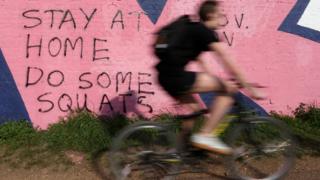 Image copyright Getty Images
Image copyright Getty ImagesCycling is one of the three examples of daily exercise the government advises people to engage in during lockdown.
Despite this, there have been reports of abuse towards cyclists, including signs in a village telling cyclists to stay away.
Some residents say riders “pose a threat” by travelling through villages and increase the likelihood of spreading coronavirus.
But is there any science to back this up?
Prof Jonathan Ball, virologist at the University of Nottingham, said cycling posed no greater risk to the public than walking, and even less of a risk than running.
He said the idea that cyclists’ heavy breathing could spread the virus was wrong.
“Somebody who’s just breathing isn’t producing sufficient particles with sufficient amounts of the virus on them to pose a threat to someone,” he said.
Prof Ball said a coronavirus sufferer who coughs produces larger droplets, whereas normal breathing – whether heavy or otherwise – only produces small droplets which are less likely to contain the virus.
“You could theoretically exhale the virus on droplets as you breathe, but you’ve got to have a minimum dose to contract coronavirus,” he said.
“Cyclists are in any part of a village for micro-second.”
Dr Kate Hattersley, a GP in Devon, said: “If you haven’t got Covid-19, you can’t spread it. If the cyclist is healthy, there’s no way they can spread the virus through your village.”
Kate Wilkinson Cross, who lives in the Hope Valley, Derbyshire, said: “Since lockdown I’ve experienced much more abuse than I have ever had while cycling in the valley.”
The lecturer said she and her partner cycled together to deliver food to a friend locally, and a driver in a pickup truck shouted abuse telling them to “go home”.
“The ironic thing was he was less than 2m away from me when it happened,” he said.
“I feel vulnerable going cycling on my own. I’m well within my rights to do so, but I don’t want to have to respond to abuse like this.
“It’s making me think twice about where I cycle.”
Intensive care consultant Dan Harvey said he had received “the odd glance” while commuting to work on his bike in-between hospitals in Nottinghamshire.
“If you’re dressed in Lycra, there’s this notion that you’ve been out for hours and hours, but in fact I just use the bike and the Lycra to cycle to another hospital,” he said.
He said there was no evidence of cycling having “any impact on local spread”.
“In fact, walking or jogging through a village is likely to have a far greater impact, as you’re interacting with surfaces more than you would on a bike.”
Mr Harvey believes cycling should be promoted for front-line health workers travelling to work.
“Public transport is either thought to be particularly risky or not available, so cycling is a good way to travel,” he said.
Last week Bradwell resident Iain Greenhalgh was one of the villagers to post their concerns about cyclists from Sheffield riding through the village.
“If you appear in the villages of the Hope Valley wearing a Sheffield Cycling Club shirt, you’ve travelled 12 miles to get here,” he said.
“Having people doing non-essential journeys through our villages makes a mockery of the effort everyone else is putting in to stay at home.”
Cycling website road.cc said a parish council had put up signs in Little Bollington, Cheshire, warning cyclists to stay in their local area.
Cyclist Gordon Hollingworth tweeted a picture of a sign in the Cambridgeshire village of Coveney, telling cyclists to “stop panting viruses through our village”.
Since road.cc publicised the signs in Little Bollington, the parish council has removed them.
It said in a statement: “We as a community welcome anyone who wishes to visit or pass through our village.
“We would ask that everyone ensures they respect social distancing.”
- Should outdoor exercise be banned and parks closed?
- Police guidelines list ‘excuses’ for leaving home
- How to exercise while staying at home
Derbyshire Police advises people to cycle “alone or with members of your household” as well as “allowing for social distancing measures”, and “under no circumstances should cycling be in groups”.
Cycling UK advises cyclists to “take the opportunity to seek out quiet and uncrowded places to cycle close to home”.
The organisation says cyclists should consider whether they will be able to socially distance from walkers on narrow lanes, or places such as canal towpaths.
Cycling UK advises people to consider “a circular route close to home” in case there is a “mechanical mishap you can’t fix yourself”.
- A SIMPLE GUIDE: How do I protect myself?
- AVOIDING CONTACT: The rules on self-isolation and exercise
- LOOK-UP TOOL: Check cases in your area
- MAPS AND CHARTS: Visual guide to the outbreak
- VIDEO: The 20-second hand wash
- STRESS: How to look after your mental health
Follow BBC East Midlands on Facebook, Twitter, or Instagram. Send your story ideas to eastmidsnews@bbc.co.uk.

